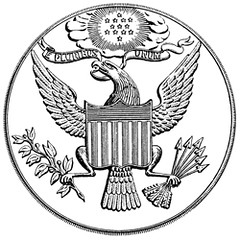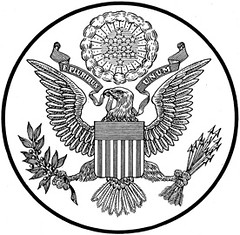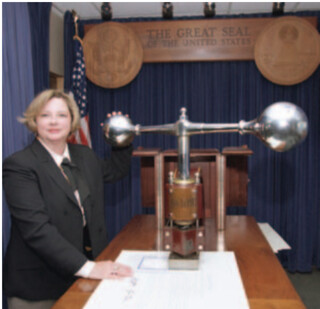
PREV ARTICLE
NEXT ARTICLE
FULL ISSUE
PREV FULL ISSUE
WHEN TIFFANY REDESIGNED THE GREAT SEALIn the either-I-didn't-know-that-or-I-just-forgot department is this item on the time Tiffany & Company was called upon to redesign the Great Seal of the United States. An ad for the venerable firm in the February 22, 2017 Wall Street Journal caught my eye. A picture of a U.S. one dollar bill in a "T & CO" money clip has the headline text
"OLD MONEY An internet search found several references. Here's an excerpt from a history of the Great Seal from the web site of the U.S. State Department, with additional illustrations from GreatSeal.com. -Editor


The 1877 and 1885 Designs
1877 The Department of State seemed unaware of any public criticism, and the irregularities in the obverse were not corrected when the Throop die began to wear and a new die was cut during 1877. The engraver was Herman Baumgarten of Washington, DC, who followed the design of the 1841 die very closely, including the errors. The seal was the same size as its two predecessors, but Baumgarten enlarged the stars and the lettering on the motto. It is considered the poorest of all the Great Seal dies, and, ironically, it was the one in use for the Great Seal’s own centennial in 1882.
1885 Whitehouse was a seal engraver, jewel cutter, and art designer of exceptional skill, taste, and artistic judgment. A great deal of research went into these two designs, going back to the original written description adopted in 1782. The Tiffany die of the obverse differs radically from all earlier dies. It is formal and heraldic, rather than realistic, and it served as the pattern for the die in use today. Its 3-inch diameter makes it larger than its predecessors, and the eagle once again carries 13 arrows. The olive branch has 13 leaves and 13 olives on it, and for the first time, the cloud of the crest is in the form of a complete circle. But it is the eagle itself that has undergone the greatest change. Gone are the thin-kneed eagles with L-shaped legs, replaced by a muscular and unmistakably American bald eagle. More of the body appears above the shield, and the engraving is so skillfully done that the break between the white feathers of the head and neck and the dark feathers of the body is visible in both the die and the impressions. In another departure, the eagle grasps the olive branch and arrows in large, strong claws from behind, not from the front, as previously drawn. Although a die for the reverse was ordered from Tiffany & Co. and funds were appropriated, the die was not cut. With the passing of pendant seals in 1871, there was no practical use for it.
The State Department document was published in 2003, but I assume the following description of the seal's use is still accurate. It would be an interesting numismatic side trip when in Washington D.C. to visit the State Department and see the Great Seal.
-Editor
The mahogany cabinet’s doors also are kept locked, and the press is bolted and padlocked in position except when in use. The seal can be affixed only by an officer of the Department of State, under the authority of its custodian, the Secretary of State. When there are documents ready for sealing, one of the officers carries them to the enclosure where the Great Seal is kept and prepares them for impressing. First, a 33 3/4-inch, scalloped, blank paper wafer of off-white linen stock is glued in the space provided for it to the left of the document’s dating clause. If ribbons are used in binding the document, they are run under the paper wafer and glued fast. Second, the document is inserted between the counter-die, with the wafer carefully lined up between them. Third, the document is held in place with the left hand and the weighted arm of the press is pulled sharply forward with the right hand, from right to left. This drives the die down onto the wafer, document, and counter-die, which impresses the seal in relief. The die is then raised, releasing the document and allowing for its removal. When an envelope containing letters of credence or recall is to be sealed, the wafer is impressed first, and then glued to the sealed envelope, leaving the envelope itself unmarked.
To read the complete articles, see:
THE BOOK BAZARREWayne Homren, Editor The Numismatic Bibliomania Society is a non-profit organization promoting numismatic literature. See our web site at coinbooks.org. To submit items for publication in The E-Sylum, write to the Editor at this address: whomren@gmail.com To subscribe go to: https://my.binhost.com/lists/listinfo/esylum All Rights Reserved. NBS Home Page Contact the NBS webmaster 
|
